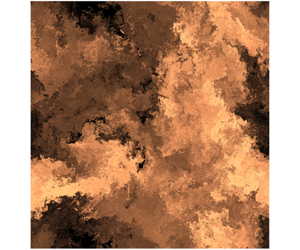Article contents
Area of scalar isosurfaces in homogeneous isotropic turbulence as a function of Reynolds and Schmidt numbers
Published online by Cambridge University Press: 26 November 2019
Abstract

A fundamental effect of fluid turbulence is turbulent mixing, which results in the stretching and wrinkling of scalar isosurfaces. Thus, the area of isosurfaces is of interest in understanding turbulence in general, with specific applications in, for example, combustion and the identification of turbulent/non-turbulent interfaces. We report measurements of isosurface areas in 28 direct numerical simulations (DNS) of homogeneous isotropic turbulence with a mean scalar gradient resolved on up to  $14\,256^{3}$ grid points with Taylor Reynolds number
$14\,256^{3}$ grid points with Taylor Reynolds number  $Re_{\unicode[STIX]{x1D706}}$ ranging from 24 to 633 and Schmidt number
$Re_{\unicode[STIX]{x1D706}}$ ranging from 24 to 633 and Schmidt number  $Sc$ ranging from 0.1 to 7. More precisely, we measure layers with very small but finite thickness. The continuous equation we evaluate converges exactly to the area in the limit of zero layer thickness. We demonstrate a method for numerically integrating this equation that, for a test case with an analytical solution, converges linearly towards the exact solution with decreasing layer width. By applying the technique to DNS data and testing for convergence with resolution of the simulations, we verify the resolution requirements for DNS recently proposed by Yeung et al. (Phys. Rev. Fluids, vol. 3 (6), 2018, 064603). We conclude that isosurface areas scale with the square root of the Taylor Péclet number
$Sc$ ranging from 0.1 to 7. More precisely, we measure layers with very small but finite thickness. The continuous equation we evaluate converges exactly to the area in the limit of zero layer thickness. We demonstrate a method for numerically integrating this equation that, for a test case with an analytical solution, converges linearly towards the exact solution with decreasing layer width. By applying the technique to DNS data and testing for convergence with resolution of the simulations, we verify the resolution requirements for DNS recently proposed by Yeung et al. (Phys. Rev. Fluids, vol. 3 (6), 2018, 064603). We conclude that isosurface areas scale with the square root of the Taylor Péclet number  $Pe_{\unicode[STIX]{x1D706}}$ between approximately 50 and 4429, with some departure from power-law scaling evident for
$Pe_{\unicode[STIX]{x1D706}}$ between approximately 50 and 4429, with some departure from power-law scaling evident for  $2.4<Pe_{\unicode[STIX]{x1D706}}<50$. No independent effect of either
$2.4<Pe_{\unicode[STIX]{x1D706}}<50$. No independent effect of either  $Re_{\unicode[STIX]{x1D706}}$ or
$Re_{\unicode[STIX]{x1D706}}$ or  $Sc$ is observed. The excellent scaling of area with
$Sc$ is observed. The excellent scaling of area with  $Pe_{\unicode[STIX]{x1D706}}^{1/2}$ occurs even though the probability density function of the scalar gradient is very close to exponential for
$Pe_{\unicode[STIX]{x1D706}}^{1/2}$ occurs even though the probability density function of the scalar gradient is very close to exponential for  $Re_{\unicode[STIX]{x1D706}}=98$ but approximately lognormal when
$Re_{\unicode[STIX]{x1D706}}=98$ but approximately lognormal when  $Re_{\unicode[STIX]{x1D706}}=633$.
$Re_{\unicode[STIX]{x1D706}}=633$.
- Type
- JFM Papers
- Information
- Copyright
- © 2019 Cambridge University Press
References
- 9
- Cited by




